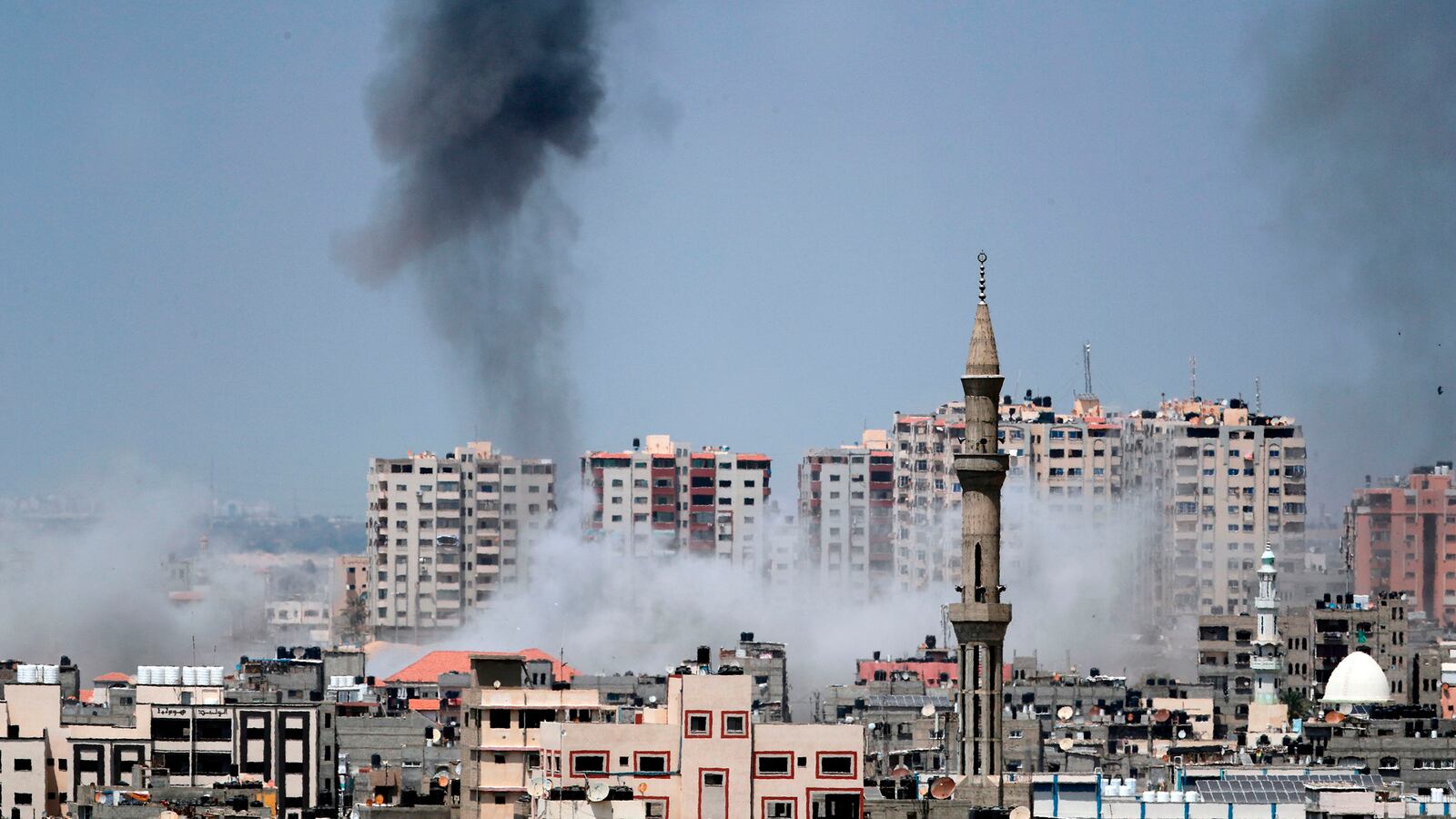TEL AVIV—Israeli villages bordering the Gaza Strip were awakened early Tuesday morning to a familiar sound: “Code Red” incoming rocket sirens. This first opening salvo fired by Gaza-based militants was just the start of a 24 hours that, when the dust settled, marked the largest military escalation in and around Gaza since the 2014 war.
In contrast to the bloody border marches inside Gaza that peaked two weeks ago, Tuesday’s events were a decidedly two-way affair. As in years past, Israeli civilians were ordered to remain close to their bomb shelters while barrage after barrage of mortars and rockets—more than 100 projectiles in all—thundered down throughout the day and into the small hours of the night.
Israel’s Iron Dome rocket defense system was kept busy, with interceptor missiles shooting into the clear blue sky in search of their prey. The entire course of the day’s events would have looked different had the system not been updated to handle these shorter-range mortars, so deadly in Gaza’s immediate environs in the later stages of the last war. “It wasn’t clear to anyone that Iron Dome could handle these mortars,” Lt. Col. Jonathan Conricus, an Israel Defense Forces (IDF) spokesman, admitted to The Daily Beast.
Going the other way, Israeli jets pounded military sites belonging to both Hamas, the Islamist group that rules Gaza, as well as Palestinian Islamic Jihad, a smaller Palestinian militant group allied with Iran and responsible for the initial mortar salvo.
All told, over 60 targets were struck inside Gaza in two separate waves, including a massive cross-border attack tunnel from Gaza into Israel that passed underneath Egypt, and what the IDF claimed were other high-value military assets.
For all the fusillades flying back and forth over the Gazan frontier, however, only a few Israelis were wounded by shrapnel and no Palestinians were reported injured or killed. This was, many on both sides admitted, nothing short of remarkable: a reflection of the Iron Dome’s improved capabilities, the early evacuation (as is customary) by Palestinian militants of their positions, and the extremely precise nature—what one veteran Israeli military columnist called “the tweezers”—of the IDF’s response.
Since the 50-day war four years ago, the axiom governing Israel-Gaza relations, repeated ad nauseam even in the middle of yesterday’s violence, was that neither side really wants a war. And yet here they both were, engaged in a live-fire exchange that ended, if reports are to be believed, only through behind-the-scenes Egyptian mediation.
While the quiet has held since early Wednesday morning, tensions remain high, and both sides are at least rhetorically not backing down. “Hamas got hit very hard last night and he knows it,” one senior IDF official responsible for Gaza told The Daily Beast. “He will have to calculate his next steps very carefully…and the IDF is prepared for any scenario.”
For their part, the Gaza-based militant factions issued a joint statement, declaring their “readiness to stop by force any aggression or stupid act by the enemy. We won’t sit with arms folded given the hooliganism of the Zionist occupation and we won’t stay silent given its crimes.”
These kinds of threats are, of course, to be expected. Yet the politics behind Tuesday’s exchange of fire is what will dictate where things go from here.
The proximate cause for Tuesday’s escalation occurred earlier in the week, when Islamic Jihad militants fired toward an IDF patrol on the other side of the border. Israel responded with tank fire against two of the group’s positions, killing three of their fighters.
This, in and of itself, wasn’t all that new or out of the ordinary for Gaza. Islamic Jihad had already vowed revenge late last year when 10 of its people were killed inside a cross-border attack tunnel blown up by the IDF. And of course, no similar escalation took place over the last two months when over 100 Palestinians, including many militants, were killed on the Gaza border fence during the various “marches of return.” But this, in truth, brings us closer to the real reason for the recent hostilities.
Since May 14, when the border marches peaked along with the death toll inside Gaza, the demonstrations have ebbed. Almost at the same time (in fact a day later), reports increased of more traditional offensive actions by Gazan militant groups against Israel over the last two weeks: heavy-caliber machine-gun fire on border communities, sophisticated improvised explosive devices on the fence, and successful cross-border infiltrations. Yesterday’s events “weren’t that big of a surprise, we saw it coming,” Conricus said. What was arguably surprising for many is that Hamas let it happen.
For all those arrayed on the Israeli side of the Gaza border during the weeks-long marches—IDF, journalists, and civilians alike—it’s difficult to overstate just how low the rocket and mortar threats were perceived to be. Hamas kept a tight leash on its own personnel as well as the other militant groups; not one projectile was fired, showing that Hamas’s writ over Gaza, as in years past, was nearly complete.
With the marches reaching their bloody denouement, however, Hamas had difficulty explaining to its own public what precisely had been gained for all those killed and the thousands maimed and injured.
True, world attention had, for a time, focused on Gaza, with Israel suffering some international opprobrium and a diplomatic crisis with Turkey. And Egypt had re-opened its long-shuttered border crossing with Gaza for the month of Ramadan.
Also true, Israel quickly repaired damage to its own border crossing with the territory, allowing the resumption of gas and fuel supplies, humanitarian aid, and other goods. Israel even expedited the medical evacuation of several dozen wounded to Jordan.
But taken as a whole, all this fell well short of the vaunted “breaking of the siege” that Hamas, and the people of Gaza, both demanded and required.
The admission by one senior Hamas leader that 50 of the group’s men were among those killed during the May 14 protests wasn’t so much done out of pride, but due to pressure: the television interviewer questioned him on why the group was letting so many Gazan civilians march into likely harm, if not death.
According to Ohad Hemo, the Palestinian affairs correspondent for Israel’s Channel Two, a demonstration by the families of those wounded took place last week in front of Gaza City’s main hospital. Hamas’s internal security force, according to Hemo’s report, dispersed the protest.
Hamas was, and remains, in the same strategic cul de sac it was prior to the last two months, with one remaining lifeline: indirect negotiations with Israel mediated by Egypt, Qatar, and possibly the U.S. for a longer-term truce, or hudna.
The thinking behind this arrangement is that a prolonged period of calm will relieve the humanitarian, economic and social pressure from Gaza, which at this point, as the IDF repeatedly tells the Israeli government, is on the verge of exploding.
If reports are to believed, Israel is demanding from Hamas and the other militant groups not just non-belligerence but a halt to their force buildup, primarily attack tunnels and rockets, in addition to the return of two Israeli civilians and the remains of two IDF soldiers held ransom by Hamas. (The civilians, thought to suffer from mental health issues, independently crossed into Gaza.)
It’s unclear what the state of these negotiations is at present. Yet it was indicative that in the midst of the barrages on his civilian population yesterday, and despite calls by some in his cabinet for a “full reconquest” of Gaza, Israeli Prime Minister Benjamin Netanyahu showed restraint. The IDF for much of the day didn’t immediately respond, let alone try to pre-empt, the firing of mortars and rockets. Moreover, Netanyahu gathered his security chiefs and defense minister in the evening—not his entire security cabinet.
“When they test us, they pay immediately. And if they continue testing us, they will pay dearly,” Netanyahu vowed Wednesday, yet his actions showed both a desire to keep the crisis contained and a preference for a political solution to Gaza’s many problems, both immediate and long-term.
The problem is that since the Israeli government isn’t demanding full demilitarization (from Hamas) for full reconstruction (for Gaza), as it has in the past, then in all likelihood the easing measures it’s offering fall short of both Hamas’s demands and expectations. Hence the reminder yesterday by Hamas that it retains, however improbably, a military option. In the Middle East, negotiations are often conducted not around a table, but via rocket.






